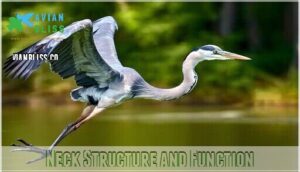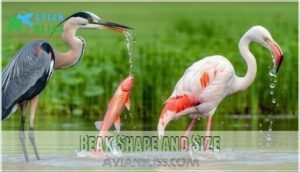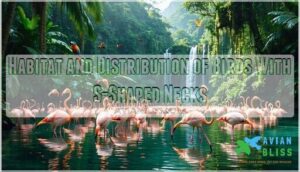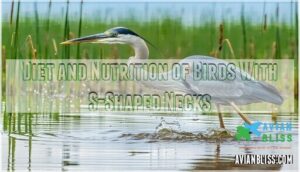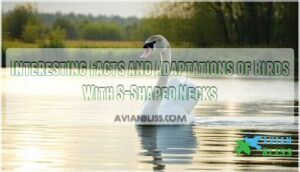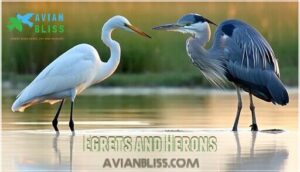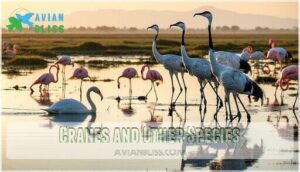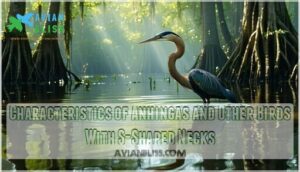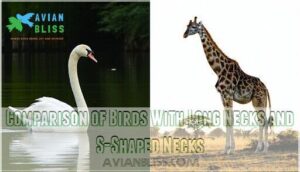This site is supported by our readers. We may earn a commission, at no cost to you, if you purchase through links.

That elegant curve isn’t just for style—it’s a practical design.
Their long, flexible necks help them hunt with precision, whether they’re catching fish or grabbing insects.
You’ll often spot these species in wetlands, lakes, or rivers, where their necks allow sudden, snake-like strikes for food.
It’s also handy for preening their feathers.
Fun fact: some species, like anhingas, stretch their necks mid-flight, looking almost serpentine.
Next time you see one, notice how this unique feature helps them thrive—it’s nature’s engineering at its finest!
Table Of Contents
- Key Takeaways
- What Are Birds With S-Shaped Necks?
- Physical Characteristics of Birds With S-Shaped Necks
- Habitat and Distribution of Birds With S-Shaped Necks
- Behavior and Social Structure of Birds With S-Shaped Necks
- Diet and Nutrition of Birds With S-Shaped Necks
- Conservation Status and Threats to Birds With S-Shaped Necks
- Interesting Facts and Adaptations of Birds With S-Shaped Necks
- Types of White Birds With Long Necks
- Characteristics of Anhingas and Other Birds With S-Shaped Necks
- Comparison of Birds With Long Necks and S-Shaped Necks
- Frequently Asked Questions (FAQs)
- Which bird has an S-shaped neck?
- What birds have an S-shaped neck?
- What wading bird has an S-shaped neck?
- What is a long-legged bird with an S-shaped neck crossword?
- What birds have a S-shaped neck?
- What is a wry neck?
- What bird has a long neck?
- Do birds have long necks?
- Why do birds have a curved neck?
- Are birds with S-shaped necks adaptable?
- Conclusion
Key Takeaways
- You’ll recognize these birds by their extraordinary flexibility – With 13-25 neck vertebrae compared to mammals’ seven, species like herons, swans, and flamingos can strike prey with lightning speed and rotate their necks for enhanced predator detection.
- Their S-shaped necks aren’t just elegant – they’re precision hunting tools – You’ll see these birds use their curved necks like coiled springs to spear fish, grab insects, and access food in tight spaces with remarkable accuracy.
- You’ll find them thriving in wetlands and aquatic environments worldwide – These adaptable species choose habitats near water sources where their specialized necks give them hunting advantages in marshes, lakes, rivers, and coastal areas.
- They’re facing serious conservation challenges that affect their survival – You should know that habitat loss, climate change, and human disturbances are threatening these magnificent birds, making wetland protection crucial for their future.
What Are Birds With S-Shaped Necks?
You’ll recognize birds with S-shaped necks by their distinctive curved cervical structure, which includes 13-25 flexible vertebrae that create an elegant, serpentine appearance.
Birds with S-shaped necks charm nature lovers with their elegant curves, powered by 13–25 flexible vertebrae for striking precision and grace.
These remarkable adaptations allow species like herons, swans, and flamingos to strike with lightning speed when hunting, while also providing enhanced reach for feeding, preening, and traversing their aquatic environments, utilizing their unique physical traits to full advantage in their natural habitats, with elegant movements.
Definition and Characteristics
What makes these birds nature’s ultimate contortionists? Birds with S-shaped necks possess extraordinary neck flexibility through specialized cervical vertebrae modifications.
Unlike mammals with seven neck bones, these species feature 13-25 neck vertebrae, creating their distinctive S-shape evolution.
This remarkable bird morphology transforms their necks into precision instruments for hunting, feeding, and survival.
These neck adaptations enable lightning-fast strikes, enhanced vision, and unmatched maneuverability, making their curved neck shape a masterpiece of evolutionary engineering.
Types of Birds With S-Shaped Necks
Ready to meet nature’s most elegant architects? Birds with s shaped necks showcase incredible diversity across multiple families:
- Herons – Masters of stealth with their distinctive heron hunting style
- Swans – Graceful waterbirds displaying the classic swan neck shape
- Flamingos – Vibrant waders famous for their stunning flamingo coloration
- Emus – Powerful runners demonstrating remarkable emu neck strength
Unique Features and Adaptations
You’ve seen these remarkable birds with sshaped necks, but their unique vertebrae modification creates something extraordinary.
Their neck flexibility isn’t just impressive—it’s a genuine survival superpower that delivers serious hunting advantages.
These feathered engineers use specialized neck vertebrae like precision instruments:
- Enhanced predator detection capabilities
- Lightning-fast hunting strikes on unsuspecting prey
- Feather camouflage that blends seamlessly with surroundings
- Aerodynamic flight positioning for energy efficiency
- Thermal regulation through neck positioning
- Intricate support systems for balance
- Stealth mechanics for silent approaches
- Precise prey-capturing techniques
Nature transforms their anatomy into multifunctional survival tools.
Physical Characteristics of Birds With S-Shaped Necks
You’ll notice that birds with S-shaped necks possess remarkable flexibility due to their specialized cervical vertebrae, which can number between 13 to 25 compared to just 7 in mammals.
These unique neck structures work like precision tools, allowing these birds to strike at prey with lightning speed, reach into tight spaces for food, and maintain perfect balance while wading through water.
Neck Structure and Function
You’ll find that birds with S-shaped necks possess 13-25 cervical vertebrae compared to mammals’ seven, creating extraordinary neck flexibility.
Their specialized muscle adaptations work like precision springs, enabling lightning-fast strikes with remarkable hunting efficiency.
This unique neck anatomy also provides aerodynamic impact during flight, while the flexible neck structure allows 360-degree rotation for enhanced predator detection and feeding advantages.
Beak Shape and Size
Beak morphology reveals nature’s precision engineering in S-shaped neck birds.
You’ll notice their sharp, elongated bills aren’t just for show—they’re specialized hunting tools designed for their unique feeding adaptations.
- Herons wield dagger-like bills for lightning-fast fish strikes
- Flamingos use curved beaks with built-in filters for tiny crustaceans
- Swans sport broad, flat bills perfect for aquatic plant grazing
- Egrets possess needle-sharp points for spearing slippery prey
Each species variation showcases remarkable bill function diversity.
Plumage and Coloration
While beak design catches your eye first, plumage tells the real story of these magnificent birds.
Their feathers showcase nature’s artistry through brilliant colors and intricate patterns that serve multiple survival functions.
Here’s what makes their plumage extraordinary:
- Feather Iridescence: Peacocks and certain herons display shimmering, metallic sheens that create stunning visual effects during courtship rituals.
- Camouflage Patterns: Bitterns and some heron species blend seamlessly into reed beds with their streaked, earth-tone coloration.
- Seasonal Plumage: Many species develop breeding colors during mating season, then molt into duller winter coats for better concealment.
- Pigment Sources: Flamingos derive their pink hue from carotenoids in their crustacean diet, while other species use melanin for darker tones.
The molting process guarantees prime feather condition year-round.
Habitat and Distribution of Birds With S-Shaped Necks
You’ll find these elegant birds scattered across nearly every continent, from Africa’s wetlands where flamingos gather in massive flocks to Australia’s lakes where black swans glide gracefully through the water.
Their habitats range from shallow coastal marshes and freshwater lakes to tropical rainforests, with many species choosing locations near water sources where they can easily hunt fish, crustaceans, and aquatic plants, allowing them to thrive in areas with abundant water sources.
Range and Migration Patterns
Understanding their physical traits leads naturally to exploring where these birds travel.
Migration Triggers like temperature changes and food availability drive spectacular journeys across continents.
You’ll witness birds following ancient Flyways – aerial highways connecting breeding grounds to Wintering Grounds thousands of miles apart.
| Species | Migration Distance | Key Flyways |
|---|---|---|
| Great Blue Heron | 2,000+ miles | Atlantic, Mississippi |
| Sandhill Crane | 3,000+ miles | Central, Pacific |
These Migratory Patterns showcase incredible Habitat Connectivity, ensuring species survival through Dispersal Mechanisms that connect diverse ecosystems.
Preferred Habitats and Environments
When you explore where birds with S-shaped necks call home, you’ll discover they’re masters of habitat selection.
These remarkable species thrive in environments that perfectly match their unique feeding and survival needs.
You’ll find them flourishing in three primary environments:
- Wetlands and marshes – These aquatic habitats provide abundant fish, frogs, and insects while offering protective cover for roosting
- Coastal ecosystems – Estuaries and shorelines deliver steady food sources and serve as critical migration routes between seasonal territories
- Terrestrial environments – Grasslands and savannas support species like emus, offering open spaces and diverse prey options
Their climate adaptations help them succeed across varied wetland bird habitats worldwide.
Protecting these areas also guarantees essential bird resources are available.
Nesting and Breeding Grounds
Romance drives these magnificent birds to select prime real estate for their families. You’ll find their breeding grounds in protected wetlands where abundant vegetation provides perfect nesting materials. Smart habitat selection means choosing spots with ideal water levels and food sources nearby.
These locations often require specific aquatic bird supplies.
| Species | Preferred Nesting Location |
|---|---|
| Herons | Tall trees near water |
| Flamingos | Mudflats and shallow lagoons |
| Swans | Reed beds and islands |
| Egrets | Colonial rookeries |
| Anhingas | Overhanging branches |
Colony size varies dramatically during breeding season, supporting ideal chick development in these aquatic environments.
Behavior and Social Structure of Birds With S-Shaped Necks
You’ll discover that birds with S-shaped necks display fascinating social behaviors, from the lifelong pair bonds of swans to the elaborate courtship dances of flamingos in massive colonies.
These species use their flexible necks not just for hunting fish and small prey with lightning-fast strikes, but also for intricate mating rituals and territorial displays that showcase their remarkable adaptability.
They utilize their necks for elaborate courtship dances.
Foraging and Hunting Strategies
You’ll be amazed watching these master hunters in action across wetlands, rivers, and coastal areas.
Their incredible neck flexibility transforms them into precision Prey Capture machines.
When Stealth Hunting, they’ll freeze motionless for minutes, then release lightning-fast Neck Extension to snag unsuspecting fish.
Aquatic Feeding strategies showcase their hunting advantages:
- Patient positioning – Stand statue-still in shallow water, waiting for perfect moments
- Strike precision – Extend necks like coiled springs, spearing prey with surgical accuracy
- Group coordination – Practice Cooperative Foraging by herding schools of fish together
These birds don’t just hunt—they orchestrate elaborate feeding performances.
Their S-shaped necks act like built-in fishing rods, giving them incredible reach underwater while keeping bodies dry above surface.
Mating and Breeding Rituals
Witnessing the mating and breeding rituals of birds with S-shaped necks reveals nature’s most enchanting performances. Males perform elaborate courtship displays, stretching their graceful necks skyward while fanning vibrant plumage to captivate potential mates.
These bird breeding ceremonies include synchronized dances, trumpeting calls, and territorial posturing that’ll leave you mesmerized. Once paired, both partners collaborate on nest building, weaving sticks and vegetation into sturdy platforms.
The female typically lays 2-4 eggs, beginning incubation periods lasting 25-35 days. Throughout chick development, parental care remains exceptional—both parents alternate feeding duties, regurgitating fish and protecting their vulnerable offspring from predators until fledging occurs.
| Species | Courtship Display | Nest Location |
|---|---|---|
| Great Blue Heron | Sky-pointing with calls | Treetops near water |
| Mute Swan | Synchronized swimming | Ground near shoreline |
| Flamingo | Group dancing ritual | Mud mounds in colonies |
| Anhinga | Wing-spreading display | Trees over water |
| Great Egret | Plume presentation | Platform in wetlands |
Diet and Nutrition of Birds With S-Shaped Necks
You’ll find that birds with S-shaped necks have developed specialized diets that match their unique hunting abilities, with species like herons targeting fish and frogs while flamingos filter-feed on tiny crustaceans and algae.
Their curved necks aren’t just for show – they’re precision tools that allow these birds to strike quickly at prey in water, reach food in tight spaces, and even filter nutrients from muddy lake bottoms with remarkable efficiency.
Food Sources and Preferences
You’ll find these remarkable water birds have surprisingly diverse diets.
Their dietary adaptations allow them to hunt fish, frogs, crustaceans, and aquatic insects with remarkable precision.
Seasonal diets shift based on prey availability – flamingos filter-feed on algae and small crustaceans, while herons prefer fish and amphibians.
Each species’ nutritional needs perfectly match their wetland habitats and specialized feeding behavior.
Foraging Techniques and Adaptations
In the context of grabbing a meal, birds with S-shaped necks are like nature’s ninjas, blending precision with power.
Their neck flexibility and sharp beaks make them experts in bird hunting techniques, perfectly adapted to wetland habitats and beyond.
These birds have mastered some impressive feeding adaptations:
- Stealthy stalking: They move slowly, necks coiled like springs, staying hidden while scanning for prey in their habitat foraging zones.
- Lightning-fast hunting strikes: With prey in sight, their necks uncoil in a flash, delivering a strike so quick it’s almost invisible.
- Ambush tactics: Some species stay motionless, relying on camouflage and patience to snag unsuspecting fish, frogs, or insects.
These hunting strategies aren’t just efficient—they’re survival tools.
Whether it’s a heron spearing fish or a flamingo sifting through shallow waters, their prey capture techniques highlight diet specialization and the incredible versatility of their S-shaped necks.
Nutritional Requirements and Challenges
Birds with S-shaped necks face dietary imbalances due to shifting prey availability and habitat loss.
Their digestion efficiency relies on diverse food sources like fish and crustaceans, essential for chick nutrition and energy.
Seasonal changes challenge their specialized feeding habits, often requiring supplementation needs.
Without balanced nutrition, these elegant hunters struggle to meet their nutritional requirements, highlighting their delicate survival challenges.
Conservation Status and Threats to Birds With S-Shaped Necks
You might be surprised to learn how vulnerable birds with S-shaped necks are to habitat loss, climate change, and human activities.
These graceful creatures face growing threats that challenge their survival, making conservation efforts more critical than ever.
Habitat Loss and Fragmentation
When bird habitats shrink, it’s like pulling the rug out from under species with S-shaped necks.
Habitat destruction and wetland loss lead to species displacement and disrupt key feeding and nesting grounds.
This ecosystem impact threatens genetic diversity and survival.
Conservation efforts, like creating protected areas and preserving wetland habitats, are critical.
By safeguarding bird habitats, we can reduce environmental impact and guarantee these elegant creatures continue gracing our skies.
Let’s protect their homes—it’s worth it!
Climate Change and Environmental Impact
Rising seas and habitat degradation create tough challenges for birds with S-shaped necks.
Wetlands shrink, prey availability drops, and migration disruption becomes common.
Add extreme weather into the mix, and survival feels like a balancing act on a tightrope.
Conservation efforts, like protecting wetlands and addressing climate change, are essential to counter these environmental impacts and help these elegant hunters thrive in their natural habitats.
Human Activities and Disturbances
Human activities like habitat destruction and pollution impacts are pushing S-necked birds to the brink.
From hunting effects to climate disruption, these threats disrupt nesting and feeding.
Urban sprawl, noisy recreation, and wetland loss leave birds struggling to adapt.
To protect gardens, consider using effective bird deterrents.
Conservation efforts, like protecting habitats and reducing disturbances, can give these graceful creatures a fighting chance to thrive again.
Interesting Facts and Adaptations of Birds With S-Shaped Necks
You’ll be amazed at how birds with S-shaped necks use their unique anatomy for survival, from striking prey with precision to spotting predators from a distance.
Their necks aren’t just elegant—they’re evolutionary masterpieces packed with specialized bones, muscles, and adaptations for life in diverse habitats, which makes them unique anatomy for their survival.
Unique Mating and Breeding Behaviors
Love is in the air for these long-necked wonders! Their mating rituals are mesmerizing, blending beauty and precision.
- Courtship Displays: Picture elegant neck dances, synchronized movements, and even vocal serenades—all designed to impress a partner.
- Nest Building: Lifelong pairs team up, crafting secure nests near water, guaranteeing safety for their future chicks.
- Parental Care: These birds are model parents, sharing egg incubation and chick protection duties, fostering strong family bonds.
Their social dynamics and teamwork guarantee chick development thrives, proving nature’s matchmaking is a masterpiece!
Specialized Feathers and Plumage
Have you ever marveled at how feathers are more than just for show?
Feathers blend beauty and purpose, showcasing nature’s artistry with striking colors, camouflage, and essential survival tools all in one.
Birds with S-shaped necks boast plumage that’s a masterclass in multitasking. Feather iridescence turns heads during courtship, dazzling potential mates like nature’s own light show.
Meanwhile, camouflage plumage keeps them stealthy, blending perfectly into reeds or water. Waterproofing feathers shield against soggy feathers, keeping birds buoyant as they wade.
Add molting adaptations, and you’ve got a built-in wardrobe refresh, replacing old feathers for peak performance.
These specialized feathers also handle thermal regulation and feather support, proving plumage isn’t just pretty—it’s pure survival genius.
Nature never skimps, does it?
Evolutionary Advantages of S-Shaped Necks
From specialized feathers to sleek necks, birds with S-shaped necks showcase nature’s engineering brilliance.
Their neck flexibility isn’t just elegant—it’s a survival masterpiece shaped by vertebrae evolution. These necks act like precision tools, blending form and function beautifully.
Here’s how they shine:
- Hunting Precision: Lightning-fast strikes make snagging prey effortless.
- Feeding Adaptations: Access to tricky spots, whether underwater or in dense foliage.
- Aerodynamic Benefits: Streamlined necks enhance balance during flight and perching.
Evolution nailed it, didn’t it?
Types of White Birds With Long Necks
In the case of white birds with long, graceful necks, you’ll find some of the most elegant and specialized species in nature.
From egrets to storks, these birds aren’t just beautiful—they’re expert hunters and skilled flyers too.
Egrets and Herons
Egrets and herons are graceful species often spotted in wetlands, showcasing their iconic S-shaped necks.
Egrets, with their bright white plumage, are smaller, while herons flaunt varied colors.
Both species master hunting techniques, spearing fish with lightning-fast strikes.
During breeding, egrets develop vibrant feathers, making them standout beauties.
Despite their charm, heron habitats and egret diets face threats from habitat loss and ecological changes, challenging conservation efforts to preserve these elegant hunters’ delicate balance with nature.
Storks and Ibises
Storks and ibises are nature’s wetland wizards, perfectly adapted to thrive in watery habitats.
Their bird neck flexibility is a sight to behold and plays a vital role in their survival.
Stork evolution has gifted them with elastic necks that stretch and compress, making hunting in shallow water a breeze.
Meanwhile, the white-faced ibis uses its elegant curve-shaped neck and specialized bill to probe mud like a pro.
- Storks tuck their necks mid-flight for better aerodynamics.
- Ibises use group foraging for efficiency.
- Long necks enhance their vision, spotting prey quickly.
- Conservation efforts protect these birds and their habitats.
Cranes and Other Species
Cranes, with their elegant S-shaped necks, are true performers in the bird world.
Their grace isn’t just for show—it’s essential for survival.
From gliding through wetlands to performing intricate courtship dances, cranes are a marvel.
Their neck flexibility aids precise movements, like spotting prey or communicating during migration.
Places like wetlands and marshes are vital Crane Habitats, supporting their unique behaviors.
Don’t forget Crane Conservation, which protects species like the majestic Whooping Crane.
Other Species such as flamingos, swans, and herons also boast incredible Neck Morphology.
Flamingos, with pink plumage from their diet, or swans gliding on lakes, all share one evolutionary secret: these necks are tools, beautifully crafted by nature.
Characteristics of Anhingas and Other Birds With S-Shaped Necks
You’ll notice that birds like anhingas, with their S-shaped necks, are perfectly designed for precision and agility.
This unique structure allows them to spear prey, twist effortlessly, and move with remarkable efficiency in water and air.
Physical Characteristics and Adaptations
Thanks to their unique vertebrae count and neck flexibility, birds with S-shaped necks are precision hunters.
Their neck anatomy, featuring spring-like cervical vertebrae, allows quick, fluid motion during strikes.
Feather support enhances stability, while aerodynamic flight reduces drag.
These adaptations also aid in thermal regulation, keeping their bodies balanced in diverse climates.
From spotting prey to lightning-fast movements, their neck adaptations show nature knows how to craft the perfect multitasking design for survival.
Habitat and Distribution
Birds with S-shaped necks, like anhingas and herons, are common in wetland habitats, coastal areas, and other water-rich regions.
Their global distribution is linked to these environments, teeming with fish and small prey, and adaptable to regional variations, migration drivers often lead these aquatic birds to conservation hotspots where food is plentiful.
Nesting near rivers or lagoons guarantees easy access to nutrients, but habitat types are shrinking due to human activities.
Protecting bird habitats secures these graceful creatures’ future while maintaining our vibrant ecosystems.
Behavior and Social Structure
With their graceful neck shape, birds like anhingas embrace fascinating social structures.
They thrive in group dynamics, using subtle communication signals to maintain harmony within flocks.
Cooperative breeding is common, where both parents share nesting duties.
Territorial behavior can be fierce, especially during mating, and swans, for instance, exhibit elegant neck movements in courtship.
These birds’ communication techniques and teamwork guarantee survival, showcasing nature’s ingenuity in bird behavior.
Their complex social hierarchy highlights collaboration in stunning ways.
Comparison of Birds With Long Necks and S-Shaped Necks
You’ll notice that birds with long necks and those with S-shaped necks share similar adaptations for feeding and survival, yet their differences reveal unique strategies.
S-shaped necks offer extra flexibility and precision, while straight long necks often focus on reach and height.
Similarities and Differences
Curious about neck anatomy? S-shaped necks and long necks share amazing flexibility, but vertebrae count and hunting styles set them apart.
Check the table below for a quick snapshot:
| Feature | S-Shaped Necks | Long Necks |
|---|---|---|
| Neck Flexibility | Remarkably High | Moderate |
| Vertebrae Count | 13–25 Vertebrae | Fewer Vertebrae |
| Hunting Styles | Precision Strikes | Broader Methods |
| Habitat Overlap | Wetlands and Water | Mixed Habitats |
| Social Behaviors | Complex Displays | Simpler Routines |
S-shaped masters like herons adapt beautifully for water habitats, while ostriches thrive on land, showcasing their unique hunting styles and Neck Flexibility with Complex Displays.
Evolutionary Advantages and Disadvantages
An S-shaped neck is like nature’s Swiss Army knife—flexible, efficient, but not without costs.
Birds with this adaptation strike prey with precision, combining neck flexibility and hunting efficiency. However, energy expenditure and aerodynamic tradeoffs make survival a balancing act.
Longer vertebrae help, but they also create challenges during swift flight or predator evasion.
Check out this breakdown:
Advantage Description Example
Unique Features and Specializations
The S-shaped neck isn’t just elegant—it’s a survival masterpiece.
Its vertebrae flexibility allows for lightning-fast strikes when hunting, giving species like the American Flamingo serious “ninja reflexes.”
The unique neck shape also aids in aerodynamic flight, helping birds cut through the air like pros.
Plus, folded necks reduce drag mid-flight.
| Feature | Function | Examples |
|---|---|---|
| Vertebrae Flexibility | Precise prey capture | Snowy Egret |
| Hunting Adaptations | Quick strikes | Great Blue Heron |
| Aerodynamic Flight | Smoother air travel | Goliath Heron |
| Feather Support | Improved balance | Black Swan |
| Thermal Regulation | Staying cool in heat | Mute Swan |
Frequently Asked Questions (FAQs)
Which bird has an S-shaped neck?
Sometimes nature bends its rules like a gymnast, creating wonders like the heron, swan, or flamingo.
These birds flaunt their S-shaped necks, perfect for hunting, preening, and looking majestic by the water’s edge.
What birds have an S-shaped neck?
Herons, swans, flamingos, and egrets are some birds with S-shaped necks.
Their unique necks aren’t just for show—they help with hunting, preening, and even courtship, blending elegance with survival skills in fascinating ways.
What wading bird has an S-shaped neck?
With 46 species worldwide, herons are the wading champs of the bird world, famous for their S-shaped necks.
These necks aren’t just pretty—they’re precision tools for snatching fish and insects with lightning-fast strikes!
What is a long-legged bird with an S-shaped neck crossword?
You’re likely thinking of the heron, a wading bird with an elegant S-shaped neck.
It strolls through shallow waters on its long legs, spearing fish with its sharp bill like a feathered ninja.
What birds have a S-shaped neck?
Birds like herons, swans, and flamingos sport elegant S-shaped necks.
These necks aren’t just for looks—they help with hunting, preening, and courtship.
Their flexible vertebrae and sharp beaks make them skilled hunters and graceful survivors.
What is a wry neck?
It’s funny how nature surprises us—a wry neck isn’t a bird feature but a medical issue.
In humans, it’s a twisted neck condition (torticollis) caused by muscle spasms, injury, or congenital factors.
What bird has a long neck?
If you’re looking for birds with long necks, think herons, swans, or flamingos.
Their necks act like nature’s multitools—perfect for hunting, flying, or preening.
Plus, they bring an elegant vibe to any wetland scene.
Do birds have long necks?
Did you know birds can have up to 25 neck vertebrae, compared to mammals’ seven?
That’s why many birds rock those long, flexible necks—perfect for hunting, preening, or just looking downright majestic in motion.
Why do birds have a curved neck?
Curved necks in birds act like built-in tools, blending flexibility and precision.
They help with preening, catching prey, and spotting predators.
It’s nature’s clever way of packing elegance, agility, and survival skills into one feature.
Are birds with S-shaped necks adaptable?
Yes, you’ll find these birds incredibly adaptable.
Their flexible S-shaped necks function like Swiss Army knives, enabling precise hunting, enhanced vision, efficient preening, and quick predator detection across diverse aquatic and terrestrial environments.
They enable these birds to have efficient preening across diverse environments.
Conclusion
Aren’t birds with s shaped necks truly remarkable examples of evolutionary perfection?
These incredible species demonstrate how nature crafts specialized tools for survival.
From herons’ lightning-fast strikes to swans’ graceful feeding techniques, their curved necks provide unmatched hunting advantages.
Whether you’re watching egrets in wetlands or anhingas soaring overhead, you’re witnessing millions of years of adaptation.
Next time you encounter these fascinating creatures, take a moment to appreciate how their distinctive neck structure makes them such successful predators.

